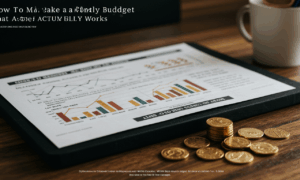Kakebo: The Japanese Money-Saving Method That’s Taking the World by Storm
In a world filled with digital budgeting apps and complex financial software, are you searching for a more intentional and mindful way to manage your money? The solution might lie in a century-old Japanese practice that requires nothing more than a notebook and a pen. The Kakebo method is a simple yet profound approach to personal finance that is gaining global popularity for its effectiveness. It’s not just about tracking expenses; it’s about understanding your relationship with money and transforming your spending habits from the inside out. This article will guide you through the philosophy, principles, and practical steps to implement Kakebo and take firm control of your financial future.
The Kakebo, which translates to household finance ledger, is a system designed to help you become more conscious of where your money goes. By physically writing down every expense, you engage with your financial decisions on a deeper level, fostering a sense of accountability that automated apps often miss. Let’s explore how this elegant method can bring clarity and discipline to your financial life.

What is the Philosophy Behind Kakebo?
Developed in 1904 by Motoko Hani, Japan’s first female journalist, the Kakebo was created to empower women to manage household budgets effectively. However, its principles are universal and timeless. At its core, Kakebo is a tool for financial mindfulness. It operates on the belief that by carefully observing and reflecting on our spending, we can identify wasteful habits, prioritize what truly matters, and achieve our savings goals with greater ease.
Unlike a rigid budget that simply dictates spending limits, Kakebo encourages a reflective process. It’s less about restriction and more about awareness. The physical act of writing forces you to pause and acknowledge each transaction, making you question the necessity and value of your purchases. This deliberate process helps separate needs from wants and aligns your spending with your long-term objectives.
The Four Pillars of Kakebo Spending
To begin using the Kakebo method, you must organize all your expenses into four distinct categories. This categorization is crucial because it provides a clear snapshot of your spending patterns and reveals where your money is truly going. Understanding these pillars is the first step toward mastering your cash flow.
The four main spending categories are:
- Survival: This category includes all your essential, non-negotiable expenses. These are the costs required for you to live. Think of things like housing (rent or mortgage), groceries, utilities (electricity, water, internet), transportation for work, and essential medical care.
- Optional: This pillar covers your wants, not your needs. These are expenses that improve your quality of life but are not strictly necessary for survival. This includes dining out, shopping for non-essential clothing, subscriptions to streaming services, and hobbies. This is often the area with the most potential for savings.
- Culture: This category is dedicated to expenses that enrich your mind and spirit. It includes money spent on books, museum tickets, concerts, continuing education courses, or magazine subscriptions. Kakebo recognizes the importance of personal growth and allocates a specific place for it.
- Extra: This is for all the unplanned and unexpected expenses. It could be a medical emergency, an urgent home repair, buying a gift for a friend’s wedding, or any other one-off cost that doesn’t fit into the other categories. Having this category helps you plan for life’s unpredictabilities.
How to Implement the Kakebo Method: A Practical Guide
Getting started with Kakebo is straightforward. You do not need any special tools, though dedicated Kakebo journals are available. A simple notebook will work perfectly. Follow these steps to begin your journey toward financial clarity.
- Step 1: Plan Your Month. At the beginning of each month, sit down with your notebook. Write down your total expected income for the month. Next, list all your fixed expenses—the bills you have to pay no matter what, like rent, loan payments, and insurance. Subtract your fixed expenses from your income to see how much money you have left for everything else.
- Step 2: Set a Savings Goal. Based on the amount of money you have left, decide on a realistic savings goal for the month. Be specific. Write this number down prominently on the page. Having a clear target is a powerful motivator. This is a fundamental practice for anyone serious about savings.
- Step 3: Track Every Single Expense. This is the most critical part of the process. Carry your notebook with you or make notes on your phone to transfer later. You must record every purchase, no matter how small—from your morning coffee to a pack of gum. This discipline builds awareness.
- Step 4: Categorize and Review. At the end of each day or week, transfer your expenses into your Kakebo notebook, assigning each one to one of the four categories: Survival, Optional, Culture, or Extra. Tally up the totals for each category weekly to monitor your progress and stay on track.
The Four Questions for Monthly Reflection
The Kakebo method is not just about logging data; it’s about learning from it. At the end of each month, the process culminates in a crucial reflection period where you answer four key questions. This self-assessment is what transforms Kakebo from a simple ledger into a powerful tool for behavioral change.
Ask yourself the following:
- How much money do you have? (This is your starting income).
- How much money would you like to save? (This is the goal you set at the beginning of the month).
- How much money are you actually spending? (This is the total of all your logged expenses).
- How can you improve? (This is where you analyze your spending, identify areas of overspending, and create a concrete plan for doing better next month).
Answering these questions honestly provides powerful insights into your financial behavior. It highlights the gap between your intentions and your actions, empowering you to make adjustments. This reflective practice is at the heart of improving your personal finance management.
Conclusion: A Path to Financial Serenity
The Kakebo method offers a refreshing, human-centric alternative to modern digital budgeting. By encouraging manual tracking and mindful reflection, it fosters a deep and lasting understanding of your financial habits. It is more than just a savings technique; it is a philosophy that promotes intentionality, discipline, and self-awareness.
By taking the time to physically engage with your finances, you move from being a passive observer to an active participant in your financial well-being. If you feel overwhelmed by your spending or disconnected from your financial goals, give the Kakebo method a try. It may be the simple, powerful tool you need to build a more secure and prosperous future.
Frequently Asked Questions (FAQ)
Do I need to buy a special Kakebo journal?
No, you do not need an official Kakebo journal. While they are designed to facilitate the method, any simple notebook or ledger will suffice. The most important aspect is the practice of manually writing down your income, expenses, and reflections, not the specific tool you use.
What if my income is irregular? Can I still use Kakebo?
Absolutely. The Kakebo method is highly adaptable. If you have an irregular income, you can adjust your approach. At the start of the month, you can base your budget on a conservative estimate of your income. Alternatively, you can fill out the Kakebo in reverse, tracking all expenses first and then calculating your savings and spending percentages once you know your total income for the month. The key is consistency in tracking and reflection.
How is Kakebo different from just making a list of my expenses?
While listing expenses is a part of Kakebo, the method’s true power lies in its structured framework and reflective process. The categorization into four pillars (Survival, Optional, Culture, Extra) provides immediate insight into your spending priorities. Furthermore, the mandatory end-of-month reflection, guided by the four key questions, forces you to analyze your behavior and make conscious plans for improvement. It’s this combination of tracking, categorizing, and reflecting that drives meaningful change.





